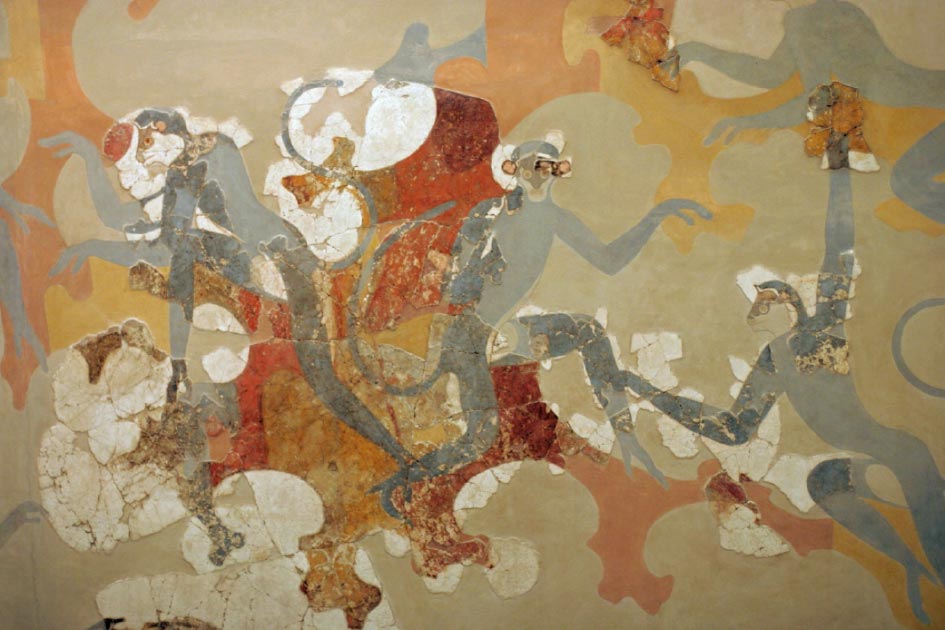Minoan Monkey Business: Fresco Links Greek Island With Asia
Experts studying ancient Minoan monkey paintings on a Greek island have made a discovery that provides new knowledge of the trade network of the archaic civilization. Analysis of a depiction of a monkey on a fresco seems to indicate that it came from Asia, thousands of miles from the Mediterranean. This find suggests that the Bronze Age civilization had links with the Indus Valley civilization, which could radically change ideas about the Minoans.
The monkey painting was found at the site of Akrotiri, on the island of Santorini (Ancient Thera), in the Aegean Sea. Akrotiri was once a prosperous Minoan settlement, which was completely destroyed and buried by a volcano in 1600 BC. The Minoans were a culture that thrived mainly in Crete and influenced the development of archaic Greece.
- 3,500-Year-Old Advanced Minoan Technology Was ‘Lost Art’ Not Seen Again Until 1950s
- New Minoan Hoard Proves Snails Were Lucrative
- Industrial Zone Found In Luxor’s Valley of the Monkeys

Close up of Minoan monkey art in Akrotiri, Greece. (ZDE / CC BY-SA 3.0)
Minoan Monkey Art
There is one very well-known painting that depicted a number of monkeys, which were different from the others. Marie Nicole Pareja of the University of Pennsylvania collaborated with some primatologists and a taxonomic illustrator, to help her analyze this wall-painting. Interestingly, monkeys did not live in Greece at this time and most of the primates painted have been identified as Egyptian species. “This makes sense because Egypt was in contact with the Minoan civilization,” reports the New Scientist. Based on the archaeological evidence, the Minoans, who were great seafarers, traded extensively with the Pharaoh’s kingdom.
After the primatologists studied the Minoan monkey images, “they all straight away unambiguously said ‘that’s a langur’,” Pareja is quoted as saying by the New Scientist. The experts specifically identified the primates as grey langurs ( semnopithecus). According to Archaeology.org, the identification was made based on the fact that the depictions had “the distinctive fur and S-shaped tail of the grey langur.” This was a remarkable discovery because these monkeys are indigenous to modern Bhutan, Nepal and the Indus Valley, which are several thousand miles away from the Eastern Mediterranean.

Real grey langur monkey playing, showing similarity with artwork. (donyanedomam / Adobe Stock)
Minoan Links with Asian Civilizations
In the Bronze Age, the Indus Valley was home to an astonishing civilization. This was a highly sophisticated urban society, which is often seen as the first civilization in the Indian sub-continent. The Indus Valley or Harrapan Civilization flourished at the same time as the Minoan (2700-1400 BC), although it had entered into a long period of decline because of environmental factors. It is possible that the Minoan monkey painting demonstrates that the ancient Greek civilization visited the Indus Valley. Pareja is quoted by the New Scientist as saying, “I wouldn’t be surprised if someday in the future we found evidence for that kind of direct contact.”
However, there is also the possibility that the Minoans were connected to the Indus Valley civilization via Mesopotamia. It is highly likely that the ancient Greeks visited Mesopotamia and saw the animals in private zoos, which were very popular with members of the elite. Travelers' descriptions may have inspired the artists who painted the monkey paintings in Akrotiri.
The Minoan monkey paintings “while stylistically Aegean, are traditionally considered closely related to—and a descendant of—Egyptian, Near Eastern, and Mesopotamian monkey imagery,” reports the academic journal Primate. Bronze Age Greek artists apparently based their ideas about monkeys on the artworks of other cultures, which were very familiar with different species of monkeys. Therefore, maybe they came to know about the langur indirectly, as a result of long-distance.
The findings of the research would indicate that the Minoans were inspired by art from regions from a much wider geographical area than previously believed. According to Primate, the research identifies “a new region that serves as a source for monkey iconography: the Indus River Valley.” It is possible the Minoans based their depictions of the langur on decorated objects with images of the primate that originated in South Asia.

Another example of Minoan monkey art in Akrotiri, Greece: ‘Potnia Theron’ painting shows goddess on the right with a monkey in front and to left of her. On the left, a young woman pours flowers of the saffron crocus in a large bowl. (Klearchos Kapoutsis / CC BY 2.0)
Minoan International Trade
There is a growing body of evidence that appears to indicate that the Minoans traded, possibly indirectly, with the people of the Indus Valley. It is known that the first Indian civilization traded extensively with Mesopotamia and many of its goods may have made their way to the Aegean. The New Scientist quotes Pareja as stating that the depiction is “evidence of this far-reaching trade, these relationships with these far-flung areas.”
The painting of a langur from South Asia on a wall on a Greek island has many implications. It indicates that the Minoans were at least indirectly in contact with the Indus Valley. They may have not only traded with them but even exchanged ideas, and this could help us to understand both civilizations better. This study and its results show the value of collaborative interdisciplinary research, and its findings are published in full in Primate.
Top image: Minoan Monkey art in Akrotiri, Greece. Source: ZDE / CC BY-SA 3.0
By Ed Whelan



















